Collect resources to build up your city, and score big by getting the right combinations for your civic buildings.
What Is Point City?
Point City is a tableau-building game for 1 to 4 players, ages 10 and up, and takes about 15 to 30 minutes to play. It’s currently seeking funding on Kickstarter, with a pledge level of $19 for a copy of the game. Flatout Games is running a dual campaign for Point City and Deep Dive (which I’ve reviewed separately); you can pledge for both games together for $35 (plus shipping). Point City is a sequel of sorts to Point Salad, but with a step up in complexity.
Point City was designed by the Flatout Games team–Molly Johnson, Robert Melvin, and Shawn Stankewich–and published by Flatout Games and AEG, with illustrations by Dylan Mangini.
New to Kickstarter? Check out our crowdfunding primer.
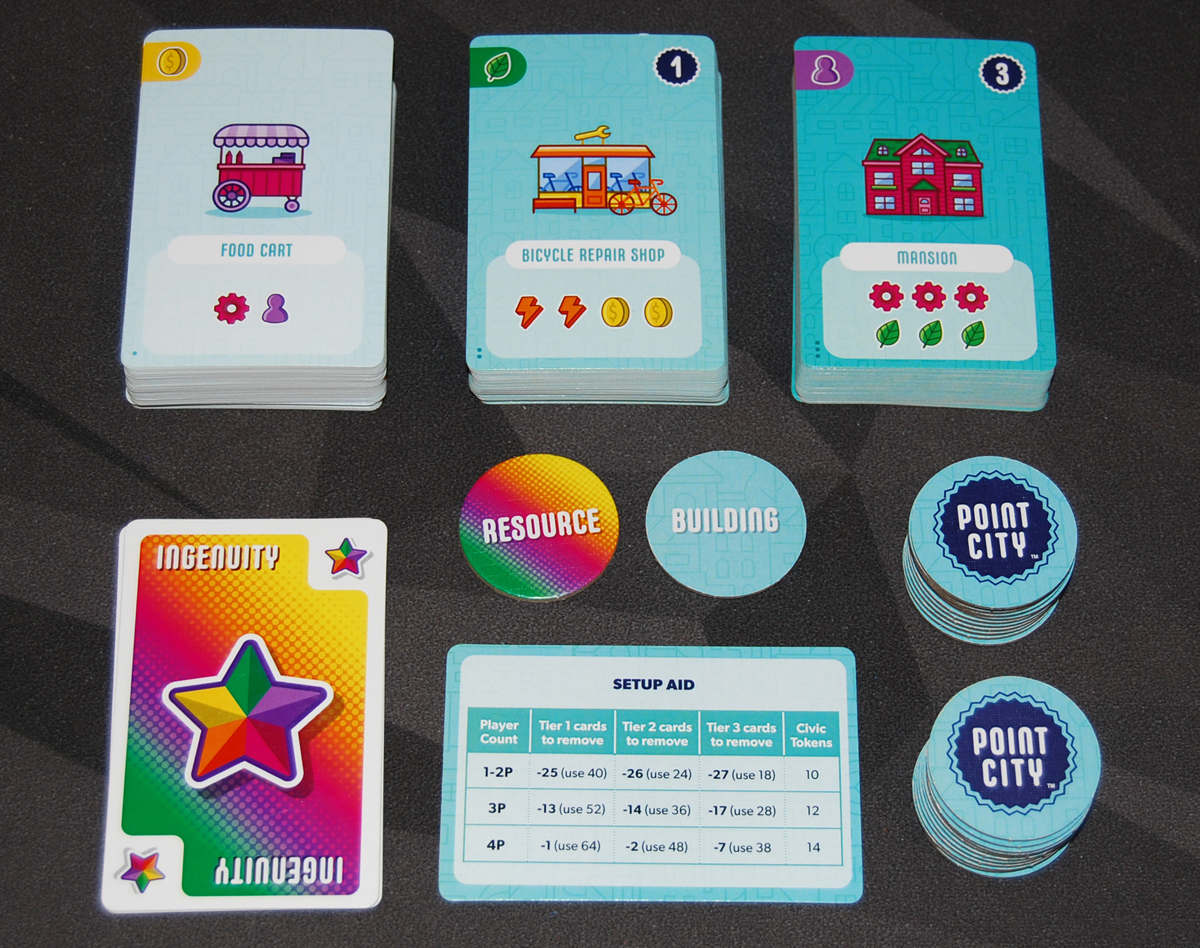
Point City Components
Note: My review is based on a prototype copy, so it is subject to change and may not reflect final component quality. That said, this particular prototype was very close to production quality so I imagine the finished game will be quite similar.
Here’s what comes in the box:
- 160 Resource/Building cards
- 4 Ingenuity starting cards
- 22 Civic tokens
- 2 Market tokens
- Game Reference card
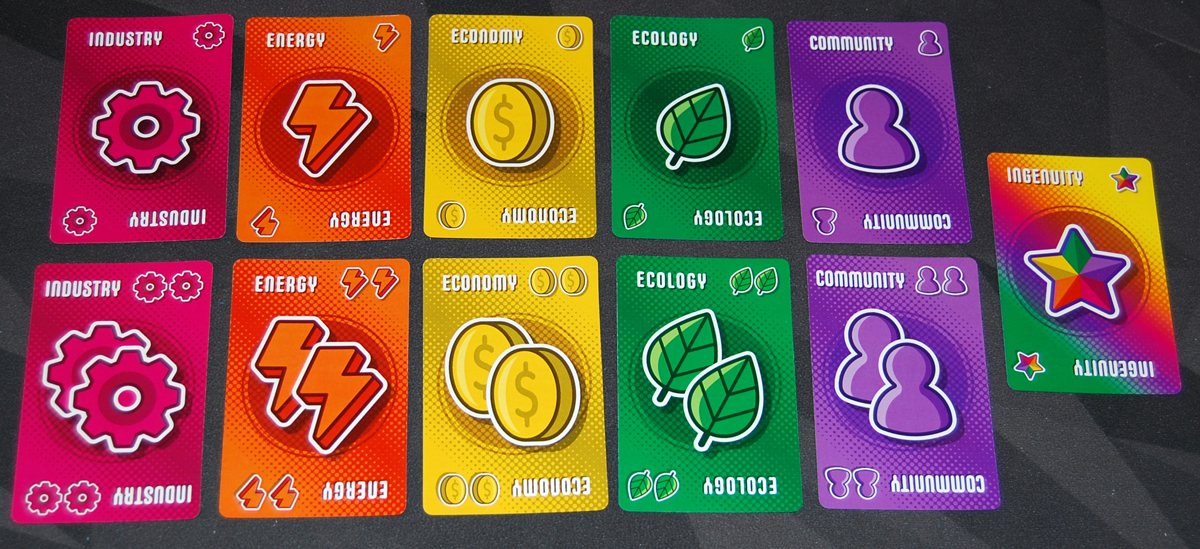
The cards in the main deck have one or two resources on the back and a building on the front. The resources are brightly colored and have oversized icons in the center, making them really easy to read even from a distance. The rainbow-colored “Ingenuity” resource is a wild resource that can be used as anything.
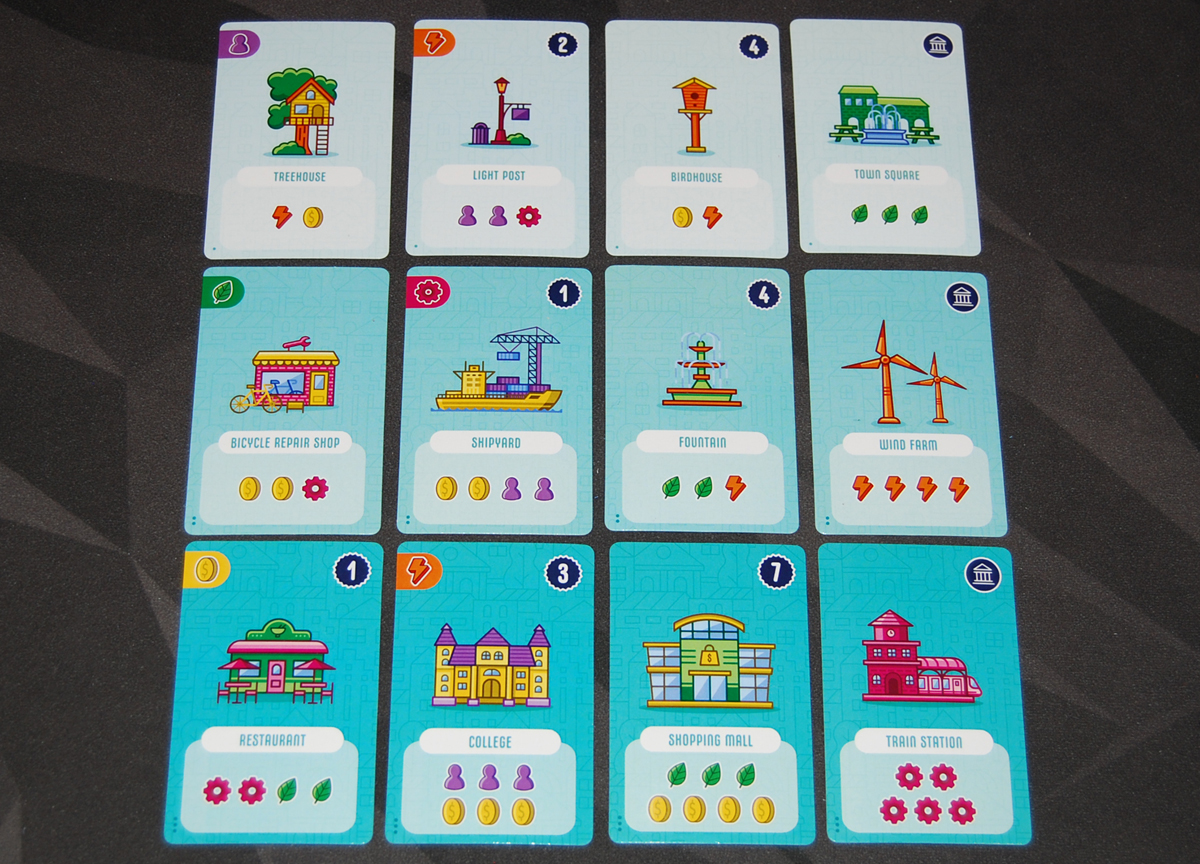
The buildings come in three tiers, differentiated by the background color and the small dots in the lower left corner of the card. As you go up in tiers, the costs of the buildings increase. Thematically, these can be a little strange: why does one birdhouse cost money and energy and gives you points but another birdhouse costs just money and produces community? There is generally some connection for the buildings that produce resources: the bike repair shop produces ecology and the restaurant produces money. But why does the college produce energy? I’m not sure.
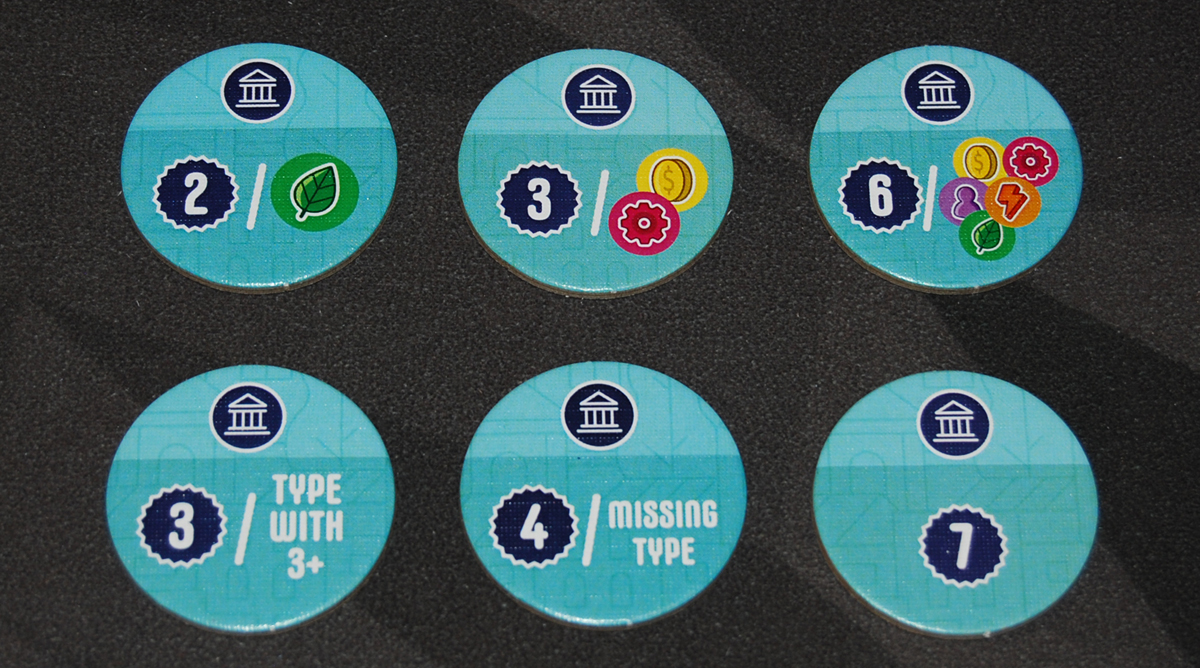
The civic tokens are small cardboard tokens that have various scoring conditions on them; these are similar to the scoring conditions seen on the backs of the Point Salad cards.

Kickstarter backers will also receive 4 promo civic tokens.
Unlike my complaint with Point Salad, there are actually enough components for the box this time. It could be a little more compact, but at least the entire plastic insert is filled up. The boxes for the two games are the same size, which makes for a nice matching, but I still wish both had been slimmed down some more.
How to Play Point City
You can find a draft of the rulebook on the Kickstarter campaign page.
The Goal
The goal of the game is to score the most points by constructing buildings and collecting civic tokens.

Setup
Separate the main deck into the three tiers and shuffle each individually, removing a number of cards based on the player count. Stack them face-down (resource side showing) with tier 3 at the bottom and tier 1 at the top. Deal out a 4×4 grid of resource cards—this is the market.
Shuffle the civic tokens and set out the appropriate number (based on player count) face-up, returning the rest to the box.
Give each player a starting ingenuity card (the white-bordered cards); whoever draws the card with the start player icon on the back will take the first turn.
Gameplay
First, if a row or column in the market is entirely resource cards on your turn (as it will be when the game begins), you may optionally flip over one card in that row or column to its building side.
Then, you must collect 2 cards, either both from the deck or both from the market. If you take from the deck, you keep them both as resource cards.
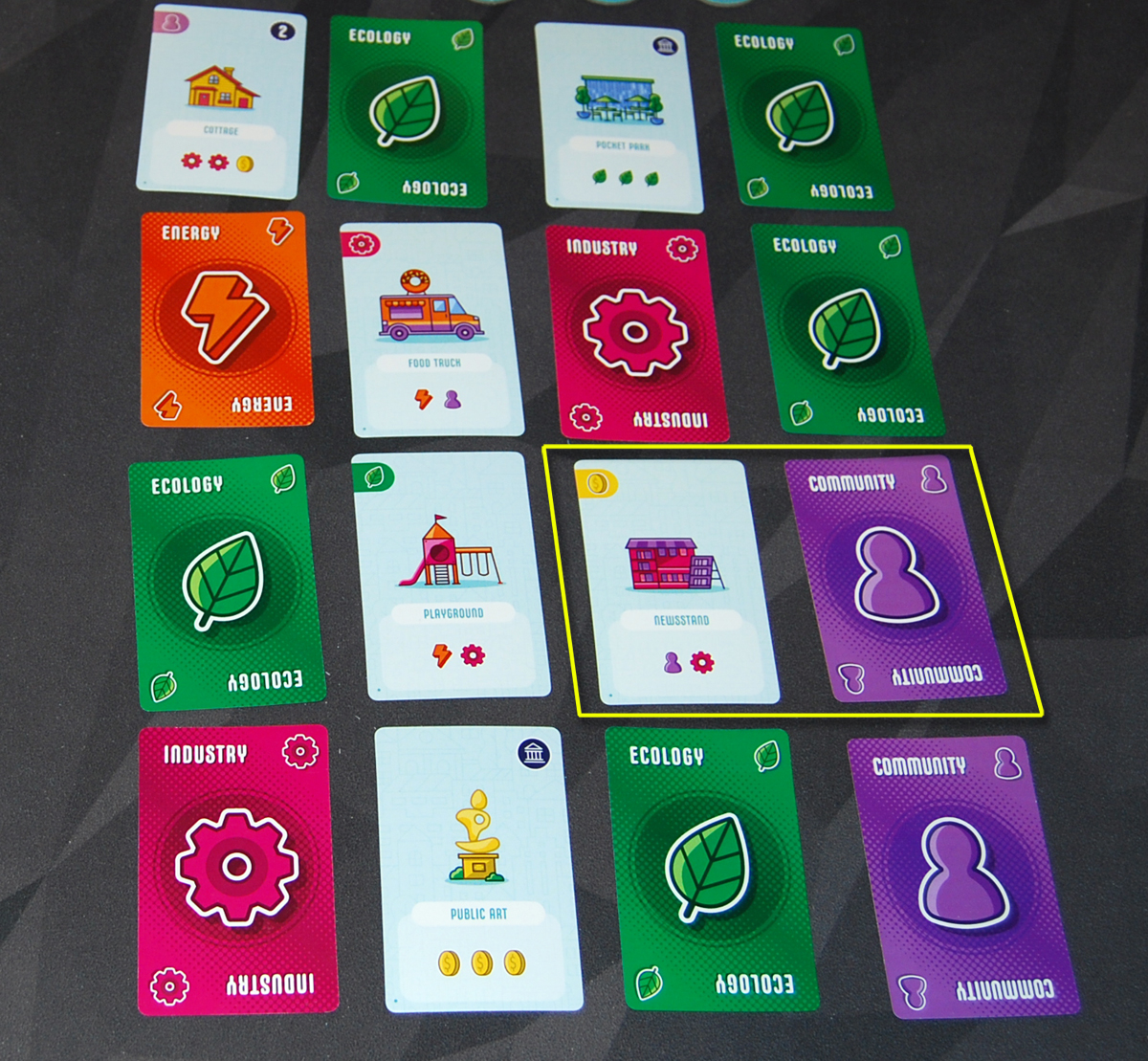
If you take cards from the market, the two must be adjacent to each other. If one is a building, you must be able to pay the costs immediately (shown at the bottom). You may pay for a building with the first card you drew; for instance, in the photo above, if I already had an industry, I could take the community card, and then use it and my industry to build the adjacent newsstand.
Some buildings have a resource icon in the top left corner—if so, that is a permanent resource that counts toward the cost of future buildings, and also may help with scoring civic tokens.
If you construct a building that has the civic icon in the top right corner, then you may claim one of the available civic tokens from the market, which may award you points at the end of the game.
Finally, you refill the market with two cards. If the card taken was a resource, then refill it with a building, and vice versa.
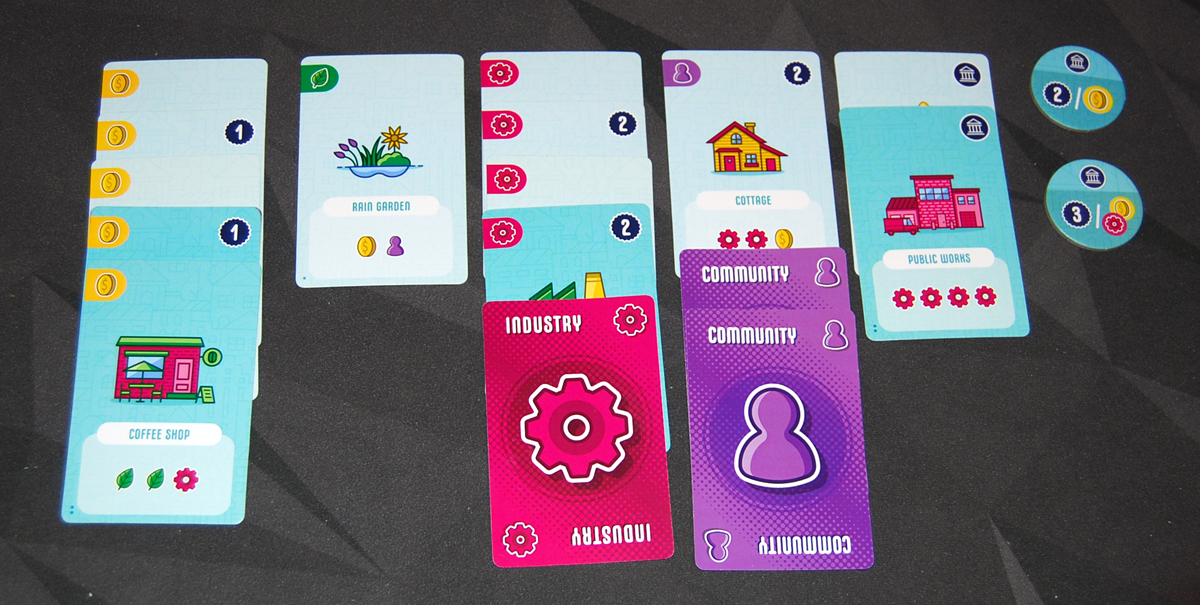
Game End
The game ends when the market cannot be refilled completely—everyone will have 17 turns.
Add up all the points—the dark blue numbers—on your buildings, plus any points earned from civic tokens. The player with the most points wins, with ties going to the player with the most unspent resource cards.
Solo Mode
The solo mode is set up like a 2-player game, and you use two tokens to track a row and column of the market grid. After each of your turns, the AI opponent automatically drafts two cards based on where the tokens are—it collects buildings and does not have to pay the resources for them, and collects the first available civic token from a row when applicable.
At the end of the game, the AI opponent scores points for their buildings, permanent resources on their buildings, and civic tokens. The number of points they get for resources and civic tokens is based on the difficulty level. On hard mode, they also score 1 point per ingenuity card.
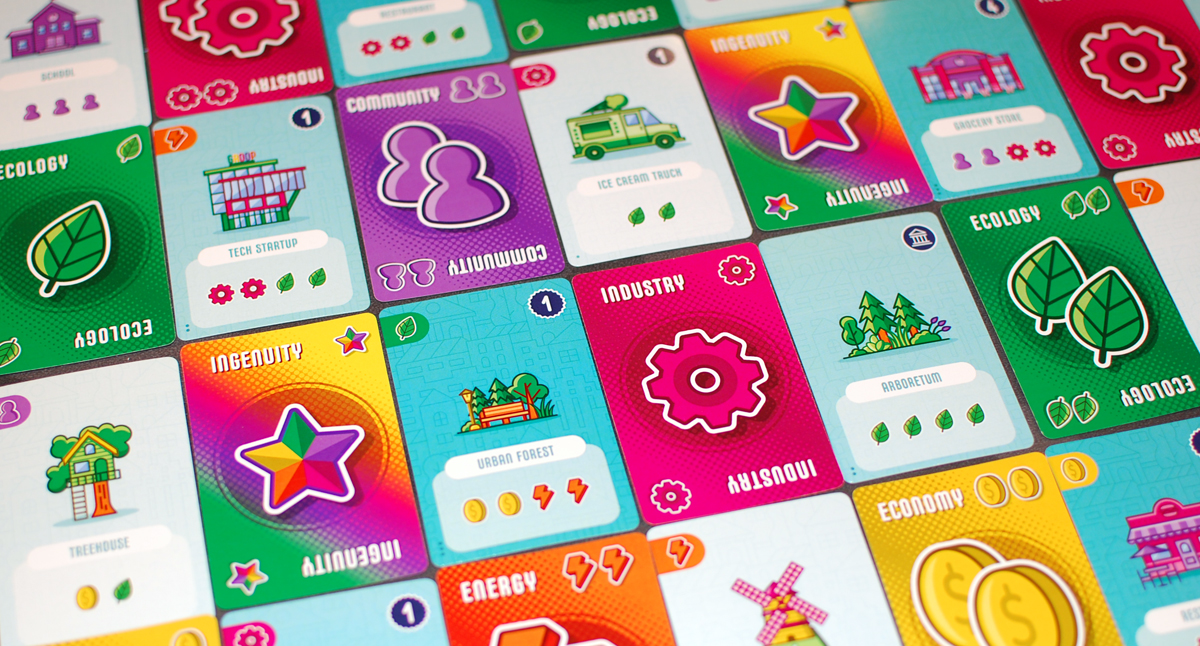
Why You Should Play Point City
I’m a fan of Point Salad, the bite-sized precursor to Point City. When I reviewed it back in 2019, I gave it our GeekDad Approved seal, and it eventually ended up as one of our Game of the Year finalists. I liked the bold, colorful look and the easy gameplay—it’s one that I feel like I can introduce to just about anyone, even if they haven’t played a lot of modern games before, but there’s enough there for experienced gamers to sink their teeth into as well.
Point City shares a bit of the same DNA—the illustrations and icons are done by the same artist, Dylan Mangini, and the civic tokens are reminiscent of Point Salad‘s scoring cards. But compared to the original, Point City has a bit more … meat.
The market is bigger now—you’re picking from a grid of 16 cards instead of 6, and there’s the added restriction that you have to take cards that are adjacent to each other. It’s also harder to get those scoring conditions that you could just pick up from the top of a deck in Point Salad: not only do you need to find a card that has the civic icon on it, but you have to have the resources to afford it as well. That means scoring for various types of buildings is now one step removed—you collect resources for the buildings and collect civic tokens to score for them. Since civic buildings never have any resource icons on them, they generally do not help you score points in and of themselves—you have to get them in conjunction with the regular buildings.
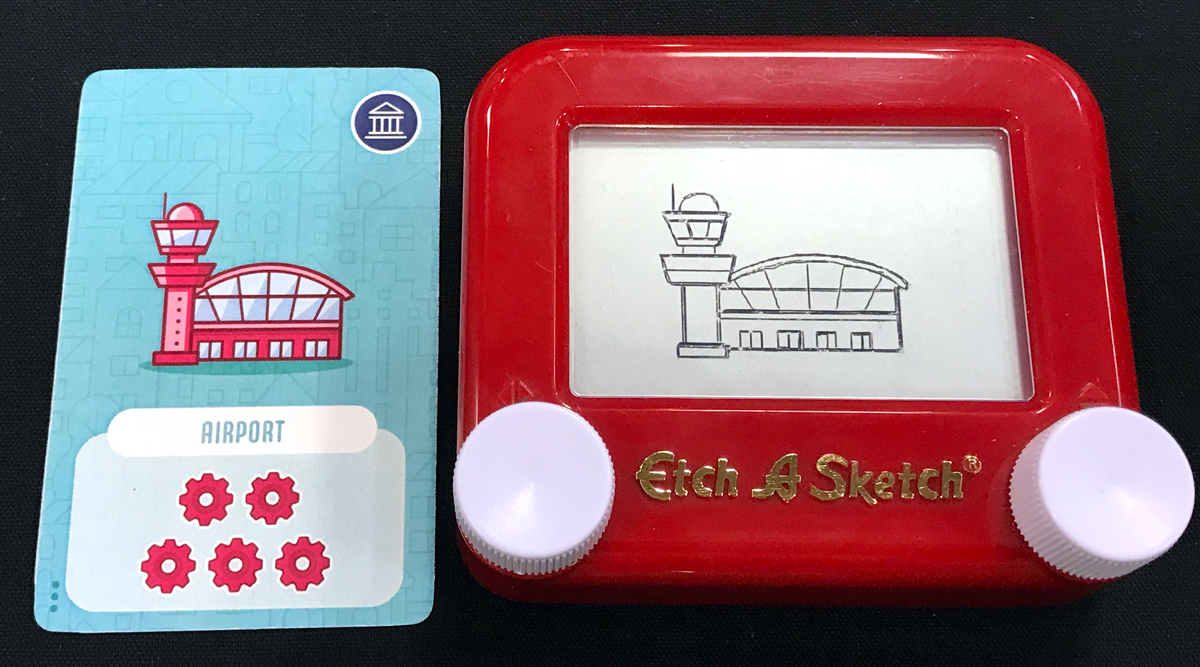
You can score points with the regular buildings too, but usually there you’re choosing between scoring points or getting permanent resources. If you go after points right away, you’re spending more resources and not building up an engine that helps you afford more buildings in the future. On the other hand, if you only get buildings that give you resources instead of points, you might have a great engine but score nothing. This engine-building is something that wasn’t present in Point Salad and gives you an additional puzzle to work on. It reminds me a little of Splendor, in the way that you can lean toward scoring points early or building up an engine to score more points later—but I’m not sure yet whether both strategies are equally effective.
So far, it seems to me that it’s pretty crucial to get some buildings that produce resources early on. Not only are those required for most of the civic tokens, but they help you afford more later on—and the buildings in the later tiers get more and more expensive. What surprised me a little is that these higher expenses don’t necessarily translate to more powerful buildings; the later tiers do have some higher-scoring buildings, but anything that produces resources still only produces a single resource. There aren’t any buildings that produce even more. And civic buildings—where your reward is always a single token—go from a 3 resources to build in the first tier to 5 resources in the third tier. If you haven’t stacked up some production by the time those cards show up, you may find yourself spending a lot of turns just collecting resources instead.
Since the market is refilled with the opposite of whatever was taken, this can also be used tactically. Taking resource cards refills the market with buildings, so if you can ensure that a particularly desired building is surrounded by other buildings, then nobody can take it unless they have enough resources to buy it and one that’s adjacent to it. The downside is that it may limit your options as well if it gets back around to your turn and nobody has put more resources into the market.
While Point City still falls in the realm of what I’d consider a casual game, it is a step up from Point Salad, and may take a little more practice for it to click. Both games are rated 10 and up, but I think Point Salad can skew younger than that, while Point City is something I would recommend primarily for kids who have some more gaming experience already. Overall, though, the two games make a nice matching set and I think there’s room for both in my library!
For more information or to make a pledge, visit the Point City Kickstarter page!
Click here to see all our tabletop game reviews.
![]() To subscribe to GeekDad’s tabletop gaming coverage, please copy this link and add it to your RSS reader.
To subscribe to GeekDad’s tabletop gaming coverage, please copy this link and add it to your RSS reader.
Disclosure: GeekDad received a copy of this game for review purposes.





